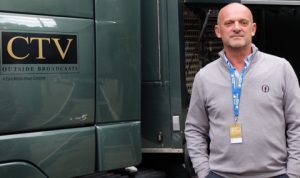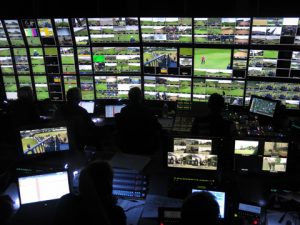SVG Europe Sit-Down: CTV OB’s Hamish Greig discusses industry challenges and training progress

Hamish Greig, CTO, CTV Outside Broadcast
CTV delivered its first Outside Broadcast back in 1983. More than three decades later, the fleet of trucks has grown tenfold and CTV’s vehicles can now be seen worldwide. Live sports coverage is the foundation of any OB company and CTV has maintained long term contracts for The European Golf Tour for ETP, Premier League Football for BBC Sport, Cricket and Darts for Sky Sports. CTV has delivered Host Broadcast services for The Rugby World Cup, The London Marathon, The University Boat Race, The Ashes, The Open Golf Championship at St Andrews plus three Live NFL matches at Wembley for the top US Sports networks.
So, with such a long-standing relationship with broadcasters, the first point of discussion with Chief Technical Officer, Hamish Greig, is obvious…
Have the demands of sports broadcasters changed over the past few years?
Sports broadcasters are always looking at innovations to enhance their production or save them money. That means, as an OB company, it makes us find solutions and keeps us at the leading edge of technology. A by-product is that transmission and record times have been extended to increase utilisation and maximise their onsite resources in both personnel and equipment.
What do you see as your biggest challenges for the next twelve months?
How to effectively implement UHD and HDR workflows, that do not radically increase costs to the production company or us as the service provider.
How do you assess the future of remote production with regard your business?
It has become another everyday strand of business which we cater for, with fewer onsite facilities and crew. And that complements our standard larger productions.

The CTV gallery for the ETP tournament
What do you anticipate will be the next innovation when it comes to IP technology?
Assuming SMPTE 2110 becomes the de facto standard, we need a network management system that is non-proprietary and works across all manufacturers’ products, to make implementation and interoperability a simpler process.
Can you tell us a little more about how Airbox works – with an example?
Airbox is CTV’s answer to a simplified production, which is easily deployable, cost effective and versatile. So far, it’s been used for live remote productions and a full range of HD and UHD productions. These include, for example Sky Ping Pong – which was a remote production, ‘An American in Paris’ – a UHD production, and the Davos World Economic Forum — to name a couple of this year’s productions.
With the continuing integration of IT and broadcast technologies, are the colleges producing engineers with the right knowledge base that will benefit OB providers like CTV?
Definitely not. Over the years we’ve been discussing with various learning institutions our future requirements and reviewing their current curriculums, with a view to adjusting them to cater for IP network-savvy engineers of the future.
Where do you think we will be with HDR by the end of this year? Or should we be looking further ahead for significant take-up?
CTV is actively working with various manufacturers to refine an HDR workflow that is effective and manageable; but we believe it will not become mainstream until next year.
